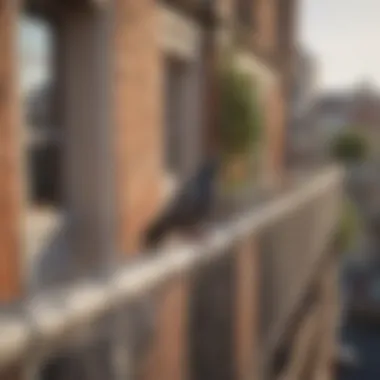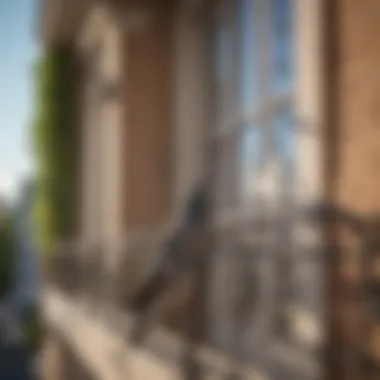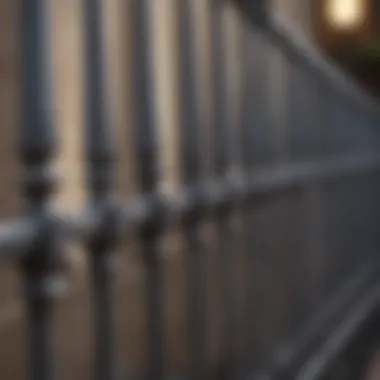Effective Strategies to Deter Pigeons from Balconies


Intro
Pigeons have become ubiquitous in urban environments, often choosing balconies as preferred spots for nesting or resting. While these birds can evoke a sense of calm in some, their presence can be bothersome to many homeowners and renters. Not only do pigeons create unsightly messes with droppings, but they also pose risks to property and health. It is crucial to address pigeon problems effectively and humanely.
This article aims to guide residents through various strategies to prevent pigeons from occupying their balconies. We will explore physical barriers, deterrents, and environmentally-friendly adjustments that are easy to implement. The discussion will also reflect on the ethical considerations surrounding wildlife management, ensuring that the solutions proposed are not only effective but also humane.
Understanding the Problem of Pigeons on Balconies
Addressing the issue of pigeons on balconies is critical for several reasons. First, it provides insight into the behaviors and patterns of these birds. Pigeons are often drawn to urban living environments, with balconies serving as prime real estate for nesting and roosting. Understanding the environmental factors that favor these birds is essential for developing effective deterrents.
Many homeowners have experienced the nuisance caused by pigeons. Their droppings can damage property and create unsightly messes. In addition, pigeons can be carriers of various diseases, which poses a health risk for residents. This makes it vital to manage pigeon populations on residential properties proactively.
By understanding both the attraction of balconies for pigeons and the problems they can cause, residents can better equip themselves with strategies to keep their spaces free from these birds. The struggle against pigeon presence focuses not only on the practical implications but also on community health and aesthetic value.
The Attraction of Balconies for Pigeons
Pigeons are naturally drawn to architectural features in urban areas. Balconies provide a sheltered, elevated space that mimics their natural environments, such as cliffs or ledges. The presence of food sources nearby can further entice them. Also, the warmth of urban heat islands and available nooks for nesting prove to be appealing for these birds. Often, balconies become unintended homes, as the structure offers safety from predators and exposure to the elements.
Common Issues Caused by Pigeons
The presence of pigeons brings distinct issues to balconies and surrounding areas. Common problems include:
- Health Risks: Pigeons carry diseases such as histoplasmosis, cryptococcosis, and psittacosis, which can affect both humans and pets. Their droppings can contain harmful pathogens.
- Property Damage: The acidic nature of pigeon droppings can erode surfaces. Over time, this damage increases maintenance costs.
- Nuisance Behavior: Pigeons cooing, nesting, and establishing their presence can be disruptive to residents, especially during the early morning hours.
Assessing the Pigeon Infestation
Understanding the presence of pigeons on a balcony requires careful assessment. This stage is crucial for implementing effective strategies against them. It allows homeowners to pinpoint specific issues while highlighting the urgency of the situation. Assessing a pigeon infestation involves recognizing signs of a problem and evaluating its severity. By doing so, residents can prioritize immediate actions and create a tailored approach for their unique environments.
Identifying Signs of Pigeon Presence
Recognizing the signs that pigeons are roosting or nesting is the first step in assessment. Common indicators include:
- Droppings: Pigeon feces accumulate over time and indicate regular visits.
- Feather Shedding: If small feathers are found, this means pigeons might be nesting nearby.
- Nesting Materials: Look for twigs, straw, and plastic that pigeons may use to build their nests.
- Coos and Sounds: Their distinctive calls can be a clear indication of their presence.
- Visual Sightings: Actual sightings of pigeons are one of the easiest signs to notice.
If these elements are present, it suggests that pigeons have settled in, which requires action to reduce their impact.
Determining the Severity of the Problem
Once signs of pigeons are identified, evaluating the extent of the problem is essential. Consider several factors:
- Quantity of Pigeons: A few pigeons present may require less immediate action compared to a large flock.
- Frequency of Visits: Observe how often pigeons return. Regular visits suggest a more entrenched infestation.
- Damage Noticed: Look for any damage to furniture, plants, or structural elements caused by their droppings or nesting activities.
- Health Risks: A high volume of droppings can pose potential health risks, including respiratory issues.
Recognizing these factors can influence your next course of action. It will help in choosing the right deterrents and strategies to effectively manage the pigeon issue.
Understanding the signs and assessing the severity creates a foundation for effective pigeon management.
Methods for Deterring Pigeons
When dealing with pigeons on your balcony, it is essential to employ effective methods for deterring them. Pigeons can cause various issues, such as noise, droppings, and even potential damage to property. Therefore, finding practical solutions is important. By addressing the problem early with specific strategies, residents can prevent pigeons from making their balconies a permanent fixture. Methods of deterrence range from physical solutions to environmental adjustments.
Physical Barriers
Physical barriers serve as a direct means to prevent pigeons from accessing your balcony. They physically block pigeons from roosting or nesting, making it an efficient approach.
Netting Solutions
Netting solutions are an effective method in preventing pigeons from landing on your balcony. This form of deterrent creates a physical barrier that does not harm the birds. The netting is often made from lightweight materials, allowing it to be easily installed. One key characteristic of netting is its versatility; it can be shaped to fit various structures.
Its major advantage lies in its ability to exclude pigeons while still allowing air and light to enter. However, maintenance is necessary to ensure that the netting remains in good condition. Over time, UV exposure or weather can cause wear.
Wire Mesh Options


Wire mesh options are another solid choice. This type of barrier consists of durable metal sheeting that can be mounted onto surfaces. Its strength makes it difficult for pigeons to penetrate or climb. A strong point of wire mesh is its longevity.
It is resistant to harsh weather and will not degrade easily. However, installation can be more complex compared to netting and may require tools. If not done properly, a poorly installed mesh may lead to gaps that pigeons can exploit.
Spikes and Dispersal Tools
Spikes and dispersal tools are also widely used to keep pigeons away. These devices are typically installed along ledges and railings where pigeons like to perch. The sharp points discourage birds from landing.
They are effective and provide a long-term solution without harming the birds. The downside is that they can be seen as unsightly. Additionally, they may not prevent pigeons from nesting if they manage to find a way around barriers.
Visual Deterrents
Visual deterrents rely on creating an environment that is uncomfortable for pigeons. Such techniques can be appealing due to their low maintenance and human-friendly features.
Reflective Surfaces
Reflective surfaces are a common visual deterrent. Materials like aluminum foil or reflective tape can confuse pigeons. The shiny character disrupts the bird's line of sight, making the area less inviting.
Reflective surfaces are popular due to their ease of use and cost-effectiveness. However, their effectiveness can diminish as the light conditions change. Regular adjustments may be needed to maintain their impact.
Fake Predators
Fake predators play on the natural fears of pigeons. Models of hawks or owls can be placed strategically to scare off the birds. These decoys are easy to set up and do not require upkeep.
One drawback is that pigeons may eventually become accustomed to the presence of these decoys, reducing their effectiveness over time. Rotation of decoys may help keep the illusion fresh.
Decoys and Models
In addition to fake predators, decoys and models can also be employed. These resemble items such as snakes or other threats to pigeons. Their design draws pigeons away, usually kept in plain view of roosting areas.
They are simple to set up. However, similar to fake predators, their novelty may wear off, requiring regular repositioning.
Audio Deterrents
Sound deterrents tap into the natural instincts of pigeons. They create an unnatural environment that encourages pigeons to seek alternatives.
Ultrasonic Devices
Ultrasonic devices emit high-frequency sounds that are inaudible to humans but distressing to pigeons. They can cover a sizable area, making them an efficient choice.
These devices are also easy to install and use low power. However, the effectiveness may vary based on the specific surroundings and distance from the device. Some may also experience sound fatigue over time, reducing responsiveness.
Noxious Sounds
Noxious sounds, such as recordings of predators or distress calls, can also deter pigeons. By creating an environment filled with sounds that signify danger, it makes your balcony less appealing.
Though easy to implement, care should be taken to avoid disturbing neighbors. Continuous use may lead to diminishing returns as pigeons adapt to the sound.
Distress Calls
Distress calls used in audio deterrents mimic the sounds of pigeons in danger. This method alerts nearby pigeons to a threat. As a result, it encourages them to leave the area.
Distress calls are beneficial because they can actively frighten pigeons away. However, constant repetition may cause pigeons to tune them out, making varied usage necessary.
Employing a combination of these methods maximizes effectiveness in keeping pigeons away. Residents should tailor their strategies based on the unique conditions of their balconies.
Environmental Modifications
Environmental modifications play a crucial role in keeping pigeons away from your balcony. These changes aim to make your space less inviting for these birds by addressing the factors that attract them in the first place. Implementing effective adjustments can significantly reduce their presence, leading to a more pleasant and hygienic environment for homeowners. This approach focuses on practical and sustainable methods, ensuring that your efforts are both effective and humane.
Cleaning and Removing Attractants


Regular Cleaning Routines
Regular cleaning routines are an essential strategy to mitigate pigeon attraction. By frequently disinfecting your balcony, you remove any food scraps and droppings that may invite these birds. This practice helps maintain hygiene, which is particularly important in urban settings where balcony spaces are often used for relaxation or entertainment. A well-kept area discourages pigeons from viewing your balcony as a suitable place for nesting or roosting.
One crucial characteristic of a regular cleaning routine is consistency. Homeowners should set a schedule that includes sweeping, washing surfaces, and clearing away debris. This dedication to cleanliness creates a deterrent effect, as pigeons are less likely to return to places that lack food or comfort. However, the downside is that some may find it labor-intensive and time-consuming. Nevertheless, the benefits outweigh the minimal effort involved in maintaining a clean balcony.
Removing Food Sources
Removing food sources is a direct approach to address pigeon problems. Pigeons are opportunistic feeders, and any accessible food can attract them. This strategy should focus on eliminating open food containers, uncovered trash, or spilled birdseed, as these attract not only pigeons but also other unwelcome pests.
A key characteristic of this method is the impact on overall hygiene. By making your balcony less of a food haven, you can effectively reduce pigeon visits. This practice emphasizes their dependency on food availability. Furthermore, it’s a beneficial choice because it promotes cleanliness in your outdoor space. One unique feature of removing food sources is that it encourages residents to adopt more vigilant habits regarding their waste disposal. The downside, however, could be the necessity of changing routines for those who typically leave food items unattended outdoors.
Clearing Nesting Materials
Clearing nesting materials is another effective approach in your strategy against pigeons. If pigeons find nesting materials on your balcony, it signals a welcome environment for them. Regularly inspecting your space for items like twigs, feathers, or even small pieces of cloth that can be readily used for building nests is crucial.
This process is beneficial as it directly influences their nesting behavior. Pigeons are less likely to settle if they cannot find materials to create a nest. It is an easy and straightforward practice that homeowners can adopt. The unique feature of this practice is that it complements the cleaning and food reduction strategies already discussed. However, it requires routine effort to ensure no materials accumulate, which could be seen as a disadvantage.
Landscape Adjustments
Plant Selection
Plant selection is a strategic option in the environmental modifications discussion. The types of plants you choose for your balcony can either attract or repel pigeons. Specifically, avoiding species that produce fruit or seeds can reduce pigeon interest in your balcony. Plants that are thorny or have dense foliage may also serve as barriers against these birds.
The main characteristic of this strategy is its ability to influence their habitat preferences effectively. By creating a less inviting landscape, homeowners can encourage pigeons to seek other areas. The unique benefit lies in the aesthetic improvement of your balcony while simultaneously deterring pigeons. On the downside, this may limit the types of plants you can choose, as not all selections are suitable for every location or climate.
Planter Placement
Proper planter placement is another vital aspect of landscape adjustments. Positioning your plants in a way that blocks off ledges or areas where pigeons typically roost can minimize their ability to settle down. The arrangement of plants can create visual barriers that discourage pigeons from approaching.
The key characteristic of this strategy is its adaptability. Homeowners can rotate and adjust their planters based on seasonality and growth patterns of their plants, maintaining an effective defense mechanism. This flexible method can continuously evolve, making it a beneficial choice. A potential disadvantage is that improper placement may obstruct views or detract from the balcony's overall aesthetic if not planned carefully.
Utilizing Vertical Space
Utilizing vertical space can effectively deter pigeons while enhancing your balcony's functionality. By incorporating vertical gardens or hanging planters, you reduce the flat surfaces available for pigeons to land on. This strategy serves the dual purpose of maximizing gardening potential in smaller areas and minimizing nesting opportunities.
The main characteristic of this method is its innovative approach to space management. It can add visual interest and greenery to your environment. Furthermore, this technique opens up unconventional options for planting and urban gardening. A disadvantage may be the initial investment and effort required to set up these vertical systems. However, the long-term benefits in deterrence and beauty often validate this investment.
Ethical Considerations
In addressing the issue of pigeons on balconies, ethical considerations should be a paramount focus. It is crucial to approach the situation with an understanding of the animal's behavior and the laws that protect them. Employing humane methods for managing pigeon populations can lead to a sustainable solution that does not harm the birds or the environment. This not only helps to create a safer living space for residents but also promotes respect for wildlife and its habitats.
One benefit of considering the ethics involved in pigeon management is the enhancement of community relations. Engaging neighbors and discussing friendly deterrents fosters a sense of unity. Moreover, it contributes to a conservation mindset, encouraging homeowners to value urban wildlife and their roles in the ecosystem.
Understanding Pigeon Behavior
Understanding the behavior of pigeons plays a critical role in developing effective strategies to deter them. Pigeons are drawn to specific environments, like balconies, that provide shelter and food. They are social birds, often nesting in places where they feel secure and can easily access resources. This awareness can guide residents on how to modify their balconies to make them less appealing.
Pigeons have a strong attachment to their nesting areas. Once they settle, they can be reluctant to leave. Recognizing their tendencies can help in creating interventions that dissuade them, instead of employing harmful tactics. Studying their patterns may reveal ways to keep them at bay, thus protecting both the birds and the home.
Harmful Practices to Avoid
While addressing the pigeon issue, it's vital to avoid methods that can create more harm than good.
Poisoning
Poisoning may seem like a convenient solution, but it poses significant ethical and ecological concerns. This method not only endangers the targeted pigeons but also poses risks to non-target species, including pets and other wildlife. Moreover, it does not address the root cause of the problem. Pigeons that die from poisoning can create additional issues, such as attracting scavengers and causing unpleasant odors. The broader impact of poisoning highlights its shortcomings as a viable deterrent.
Trapping
Trapping can appear to be a straightforward method to control pigeon populations. However, it often leads to stress for the birds and can result in injury or death if not handled correctly. Moreover, trapped pigeons must be relocated or managed humanely, which can be a challenging process. The effort required often outweighs the benefits. Additionally, if one population is removed, others may simply move in to take their place. This approach does not provide a sustainable long-term solution to the infestation.


Removing Eggs or Nesting Materials
Removing eggs or nesting materials is another method but carries significant ethical implications. Interfering with their reproductive cycle can be seen as cruel and disrupts the natural behaviors of these birds. While it may provide a temporary respite from nesting, it raises concerns about animal rights and can lead to negative consequences. Furthermore, the effort required to continuously remove anything they try to build may become counterproductive.
"Ethical wildlife management encourages strategies that respect animal behavior and promote humane solutions."
In summary, prioritizing ethical considerations when dealing with pigeons is essential to developing effective, humane strategies. Understanding their behavior, avoiding harmful tactics like poisoning, trapping, and removing nesting materials can lead to a healthier environment for both residents and wildlife.
Using Professional Services
Engaging professional pest control services can be essential when managing a pigeon issue on your balcony. These services bring specific skills and expertise, which can produce more effective results than DIY methods. They can assess the situation accurately and implement appropriate strategies based on their experience. Making the choice to involve experts can give you peace of mind, knowing that the problem is handled by those who understand the complexities of pigeon behavior and control.
When to Seek Help
You should consider professional help when the infestation appears beyond your control. If you notice a significant number of pigeons on your balcony, or if previous deterrent measures have failed, it might be time to consult an expert. Also, if pigeons have begun nesting or if they return repeatedly, a pest control professional could provide more permanent solutions. Their insights on pigeon habits can lead to more targeted strategies.
Choosing the Right Pest Control Service
Certifications and Qualifications
When selecting a pest control service, certifications and qualifications are crucial. Professionals with relevant certifications indicate they have received proper training and are equipped to deal with pigeons ethically and effectively. This expertise ensures they understand the legal implications of bird control, including humane practices. Choosing a service with recognized qualifications results in an informed approach to pigeon removal, which aligns with ethical wildlife management principles.
Service Reviews
Service reviews can be a vital resource when deciding on a pest control provider. They offer firsthand accounts from previous clients regarding the effectiveness and professionalism of a service. Positive reviews often suggest a reliable company that delivers satisfactory results. Conversely, negative reviews may serve as a cautionary note, prompting further research before commitment. Overall, reviews can save time and money by pointing out reputable services and helping you avoid potential inconveniences.
Ethical Practices
Ethical practices in pest control include humane methods, such as relocation rather than extermination. Services that emphasize ethical considerations usually have better long-term reputations. Choosing a pest control provider with a strong commitment to ethical practices is essential for ensuring that the solution respects both the pigeons and the environment. This choice benefits not only your immediate situation but contributes to a broader awareness of responsible wildlife management.
"Achieving a balance between effective pigeon control and ethical treatment is essential."
By thoughtfully considering your options and relying on certified, reviewed, and ethical services, you enhance your chances of maintaining a pigeon-free balcony.
Maintaining a Pigeon-Free Balcony
Maintaining a pigeon-free balcony is essential for ensuring the comfort and health of your living space. It is not just about aesthetics; the presence of pigeons can lead to hygiene issues and property damage. Pigeons are notorious for their droppings, which can corrode surfaces and create unsightly messes. Beyond the cleanliness factor, the risk of pests and diseases associated with pigeon droppings can pose health risks to residents. Thus, this section aims to explore practical strategies to sustain a balcony environment free of pigeons by implementing consistent monitoring and preventive measures.
Regular Monitoring Techniques
Regular monitoring is critical in catching any signs of pigeons before they become an established problem. This technique involves routine checks of your balcony to identify any fresh evidence of pigeon activity. Look out for droppings, feathers, or nesting materials. Establishing a monitoring schedule can help detect patterns in pigeon visits or nesting behavior.
One effective approach to this monitoring is using visual trackers, like a simple logbook. Record dates and observations of any pigeon activity. This can assist in recognizing peak activity periods and better inform your strategies. Remember, early intervention often prevents larger infestations later, reducing the hassle of removal strategies.
Preventive Measures Moving Forward
Implementing preventive measures is imperative in sustaining a pigeon-free environment. Such measures can be grouped into three main subdivisions:
Routine Cleanliness
Keeping your balcony clean is a fundamental aspect of preventing pigeon infestations. Regularly removing debris, food scraps, and organic matter deprives pigeons of potential attractants. A focused cleaning routine emphasizes the importance of removing standing water, too. Pigeons need very little encouragement to visit, and cleanliness is a key part of keeping them away.
A characteristic of routine cleanliness is its simplicity. It requires no technical skills, just consistent effort over time. One of the primary advantages of this approach is that it is cost-effective. There are no recurring expenses for deterrents or professional help, making it a practical choice.
Periodic Maintenance of Deterrents
Periodic maintenance of deterrents helps ensure that strategies remain effective over time. Whether physical barriers or visual deterrents like reflective surfaces are used, regular checks are necessary. This process involves evaluating for damage or wear and addressing any issues immediately to maintain effectiveness.
The key characteristic of this method is its proactive nature. Maintaining existing deterrents means avoiding the cost and hassle of more intensive measures later on. A disadvantage might be that residents often overlook this aspect, as maintenance sometimes feels less urgent than immediate cleaning or removal techniques.
Continued Learning
Continued learning involves staying informed about best practices and emerging methods in pigeon control. Engaging with community forums or educational resources can provide new insights. The importance of this aspect lies in adapting to changing behaviors of pigeons in urban environments.
The key feature of continued learning is the ongoing nature of the approach. As new challenges arise, being informed can minimize future issues. A potential disadvantage is that this requires a commitment of time and energy, which some may find challenging amidst their busy lives.
"A consistent monitoring and preventive approach is the best long-term strategy to ensure your balcony remains pigeon-free."
In summary, a combination of regular monitoring, routine cleanliness, periodic maintenance of deterrents, and ongoing education plays a vital role in maintaining a pigeon-free balcony. This careful attention not only enhances the enjoyment and utility of outdoor spaces but also protects your living environment from potential health risks.



